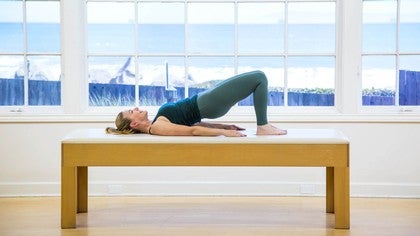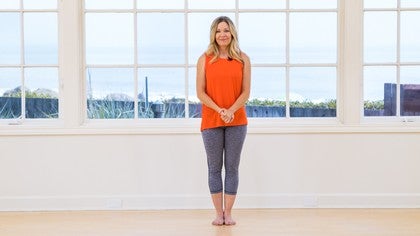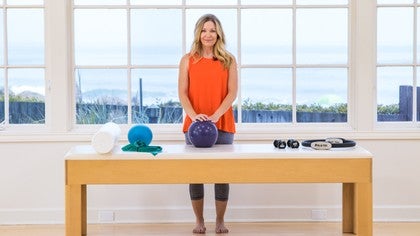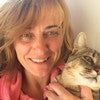Description
About This Video
Transcript
Read Full Transcript
Alright. Hi everyone. My name is Amy. I'm here to teach you and take you through a fundamental flow. These fundamentals are really the prerequisites to the place mat work. You can kind of consider them pre prerequisites in a way. Um, there'll be some really basic movements, uh, that are really leading us into deeper [inaudible] exercises in the mat and all of the repertoire and the method and our intention for you to learn them this way from the very beginning is to set you up for success so that along the way during your mat work, you'll already have these fundamentals laid down in your body and in your mind and in your mouth, body memory, so that when you're taking classes, future classes, you won't have to look at the camera all the time and say, wonder what she's doing? Wonder what he's teaching. These are where they start. Okay? Not all the teachers on this website use these words, but these concepts are clearly, clearly through all of the exercises that you'll learn. All right, so join me.
We're going to lie on the Mat. You don't need anything except you and your mat, your mind, and your eagerness to learn. So the first fundamental I want to take us through and begin our, our fundamental flow is breathing. Let's all put our hands on the side of our rib cage. Gently press your hands against your side ribs. Our intention is to really feel how those ribs expand and narrow while we breathe in. And out. Breathing is our first fundamental.
So we'll be getting with that. I like us all to take your hands to the side of our rib cage. And what we're after with breathing is to increase the, the diameter of our ribs, the expansion of our lungs, the volume within our body, and then during the exhalation and atoning that and changing that and making it a little bit narrower. So maybe you can think of it as a circumference, change, a whitening expansion, and then, um, a changing of shape at getting a little bit of s of small. Okay, so let's go. We'll take a deep breath through our nose and exhale through the nose or the mouth softly. Let's take that again. Inhaling through the nose and exhaling softly out the mouth or nose.
Let's try to get through five of these right now. Inhale and again, exhale, and as you exhaling, they're starting the beginning of some abdominal muscle, toning, die from muscle toning, getting right into touching into the center body of you, your lungs, and your diaphragm. A couple more times. Well, the feeling, how you can expand your rib cage self there and your exhale.
You actually actively have to bring your body weight heavier on the Mat. All right, so as you inhale, ease out of that effort a little bit during your exhalation. It is as if you can, we can pull ourselves down against the mat a little heavier. You might start to feel the how that's kind of inviting some work and some effort in your abdominal region to imprint your body onto the mat. Okay, let's try a few more of these. Inhaling through your nose.
As you exhale, we're imprinting the back of our body on the mat, so that's the back of the headlight, Leigh, the back of the shoulders, rib cage, low back, pelvis, even the feet. Try it again. Inhale gets a little lighter and exhale. We're working to imprint. Leave an impression almost with the back of your body on your mat. What would that look like? If you stood up right now and took a look down on your mat, you'd want to see your impression there and can I stick it one more time? Inhale and exhale imprint later.
You'll probably learn more sophisticated imprinting. I know you will certain sections of your body on the back of your body to imprint, but right now the general concept, this fundamental concept is the ability to leave your impression, imprint your impression down on the mat. All right, good. Let's move on to the pelvis. Work in on something called our pelvic bowl. But your hands on your hips, your pelvis right here, your right hip and your left hip or pelvis. Hips sometimes are on the outside, but your pelvis is going to be here. Let's imagine that all of this, your, your contents right now is you're filled with like water or something kind of like liquid. Maybe something like our ocean outside to tip, move the pelvic bowl. We're starting to work on a concept of how to mobilize the pelvis from the lower spine. So this idea that this is all water.
If we sloshed the water in different directions right now I'm going to Slosh the water of my bowl toward my chest, right? So all that is going to spilling down toward my, my um, chest wall there. And then if I slashed the water the opposite way, kind of washing the water down the front of my body toward my pubic bone, maybe even down toward the feet. Okay, I'm going to put my hands on my two hipbones pelvis and do it again. So if I slosh the water of the bowl toward my chest or face, see how I'm leaning, we're leaning the pelvis and then as we're slashing the opposite way, we're taking the pelvis and kind of reaching or leaning the opposite way. We're mobilizing it. Let's do it again and pelvic bowl can reference your pubic bone part of your pelvis and that's making an arch fashion toward your chest and then the opposite pubic bone down between your legs toward your feet and again, twice more so sloshing than water of your bowl toward your chest. There's a little imprint going on in your low back and then sloshing the water towards your feet.
You lose that imprint of your back and create a little arch. Let's do it again and slosh one more time towards your face and then sloshing towards your feet. Okay, that's one w two directions of the bowl. The bowl has a bottom of it and it can move all around. We're going to move our pelvis right and left, said, keep your hands on your hipbones there, everybody, your pelvis and see if you can slosh that internal water or his contents toward one side of your pelvis and then over to the other side of your pelvis. Put your your mind for a minute on the back of your pelvis. Okay.
This may be something to feel if you lean your pelvis to one side, the back of that hip pelvis gets heavier and then if you lean the pelvis to the opposite side, see the back of that side is getting heavier and experiment with that go side to side. If you like the image of the water in the bowl, slosh it and slosh. You're mobilizing that water, that liquid. Okay, so let's see what it feels like to move the ball in a bigger way. Started where the water is still, your pelvis is still, let's go to the first movement we did. We took that water, we slosh it toward our chest. Now slush it to one of those pelvic halves and slush it down towards your feet and then slosh it to the other half of your pelvis and keep going. You're going to just start to feel this beautiful mobility of your pelvis around your low back, around the top of your thighs and if you wanted to do a little sense of kind of pulling your tummy muscles, that band of abdominal area here in more fuel, how that musculature tones inside. Okay, go the other way and it might feel a little uncoordinated.
That's okay. You're learning how to move a very specific place of your body in a very specific way. This is a bowl like movement sloshing the water around. Okay. I particularly like the use of water. Not all teachers use that imagery or that concept. That's okay.
All right. Now let's go ahead and find some stillness in that region and just feel that stillness and I want you to recognize the stillness is a word you'll hear called stabilization that your pelvis is now very anchored. We've mobilized a lot. We're going to work on something to stabilize it McKay, and that is the nice way. So let's work on that. Move your hands right into the the touching note, right and left pelvis here and your bumpy bones on the front of your pelvis. And then take your knees and your thigh bones, leaning them or swaying them toward your right or your left, your feet.
We'll probably move a little bit. That's fine. See if he can do the leaning of your thigh bones, but keep your bowl of your pelvis really still. Okay. And then transition. Bring your thighs to the center. Move your thighs and knees to sway the opposite way so it's pretty small. All right, keep moving. Let's just kind of go. There's no specific timing on this.
Everyone sway your knees to the right or left. Bring them through center and then sway them to the opposite side. All right, keep doing that. And notice you're doing a beautiful job of differentiating. This is a type of a kind of a big word, differentiate or disassociate, meaning you can move your thigh bones independent of your pelvis because you're really moving right at the joint of your hip.
You're going to learn all about that a lot. So good to strengthen your hips and doing that with some abdominal band. Again, this area right here, toning that meaning, engage it inward like you've got a belt on the seatbelt, tached to the mat maybe, and then you can move those thighs. Let's go just a wee bit faster this way and sway so the abdominal muscles are starting to get some workout. I don't know if you can feel that. It's really deep and internal. Okay, so that's nice way. Now let's work another one. The knee stor.
Place your hands on your thighs, one on each, and I want you to pick up one leg, bring that side toward your chest and then place that foot back down. We'll be alternating Lynne, lift the other leg, thigh toward chest, and then put it down. My Foot's relaxed, my knee is relaxed and really just moving my thigh. But again, being able to do this thigh movement, but keep your spine and your pelvis nice and still or stable. You'll hear the word stable a lot, okay? Again, this is another form of the disassociation concept. Conditioning your hip joints. Do One more each thigh and now keep this thigh in.
Place your hands both hands on top of that knee and we're adding the stir meaning move your thighbone in a circular movement clockwise or counterclockwise. Once again, trying to remain very still in your pelvis and your spine. Go the other way. See if you can internalize this and try to tone your internal abdominal area, that band of Tummy so that you keep your hips pretty still. Okay? Take that leg down. This all matters at a fundamental level. Take the other leg in so that you can really learn these small movements later.
Get very big, a lot more muscular, bigger tasks, a lot more challenge. Learn it fundamentally. Now it'll be a much more gratifying later. You're stirring that thigh.
The objective here of being able to slide that leg, keeping the pelvis and spine still, you might start to feel now some back muscle activation that's coming into play because you're having more weight to move away from you. All right, so this is our leg slide. Stay out there and flex your ankle does reach your heel bone forward. Relax your foot and slide the leg back in. Let's do it again and slide the lay forward.
Flex your heel, relax your foot and slide it back in. I'm going to have everybody take an inhale through their nose. Exhale as you slide.
Exhale, slide the leg.
Inhale through your nose. Exhale, slide your leg out. Any heel flex your ankle is to just feeling your heel. Reach forward, toes pulling back. Exhale, slide the leg back in. Once it's in, taken, inhale through your nose and exhale and slide and in heel, flex your heel and a little visitor outside and exhale, slide the leg back in. Okay, two more times. Inhale, so again, I have a feeling you're probably feeling some muscle tone around your abdomen and probably in your lower back. That's great. That's great to feel that. Come back in one more time. Inhale through your nose and exhale and slide the leg out.
Flex the heel as you breathe in. Exhale and slide the leg back in. Eventually you'll do lots of leg movements quicker, maybe another fundamentals flow, but right now let's work on something called bridging. I'm going to move my hands out of the way for this one just up to my ribs so that you have more. See a visual of my hips and pelvis. Two kinds of bridging you'll learn didn't this fundamental flow.
You're going to do both of them. First one is a level pelvis or you're going to hear a neutral bridge. What that means, I want you just to lift your pelvis above the mat, but your landmarks have stayed the same, so your hip, your pelvis, pelvis, and your pubic bone still on the same plane and then just set that down. Inhale again, exhale and simply levitate almost your hips above the mat. This is very small, but once again, you're probably starting to feel an introduction of some back muscle work.
That's good. And again, press deaf, feet down. Just simply lift your pelvis and set it back down one more time. This is a neutral bridge and press lift, so your landmarks of your pelvis have stayed parallel to your mat and lower. Another kind of bridging starts with the pelvic bowl movement, so take a breath through your nose. Raina slashed the water again, so a year ago there goes that sloshing. Now instead of just stopping there, continue all the way, you're going to roll your spine so that your hips are well above the mat.
You're about the midway of your back above the mat and then just roll yourself back down. Okay, we'll do several of these. Come back to a nice still bowl. Breathe in through your nose.
Slashed that water. This is a concept of the articulated bridging, so we're trying to learn about how to segmental move our spine. Take an inhale through your nose.
There are long. And we get to study the front of our pelvis just for a brief moment. So it's another form of imprinting. And now you get to imprint the front of your pelvis. So that's that pubic. But bone, your hip bone on the right and your hip bone on the left.
And as you imprint your pelvis, you may feel that internal tone of your abdominals just naturally occur. That's a wonderful thing. And in so doing the whole objective too with what we're about to do is that nice long, low back region. Okay, so this is prone hip extension. Think about it from your leg, your thighbone. We did a lot of that in the other exercises there.
So as you take one thigh and lift one thigh a little bit above your mat, you're actually moving from your hip joint again in raising your thighbone from your hip joint above the mat. I want you to stay there for a moment and feel the front of your pelvis imprint. Okay? And essentially we're keeping all the points of the pelvis, the pubic bone, and the two hip bones evenly weighted. Lower the thigh down. Let's alternate legs. Take a breath through your nose first.
Want you to imprint your pelvis in the front, raise your opposite thigh. It's not high, it's not high, it's long lengthening and but making sure that you have even weight across those two hip points in the front and the pubic bone and lower your thigh. Let's go again. Inhale through the nose, keeping that pelvis imprinted in the front. Raise that first thigh and says extending the hip and lower the thigh down. Inhale through the nose, keeping that pelvis imprinted evenly weighted and raise that opposite thigh.
Inhale and exhale as you lower the thigh down so we'll continue all alternating legs. Some of you are probably starting to feel exhale, the first thigh, some more muscle around your buttocks, your hips in your low back. Contracting and toning. Congratulations. That's really great. That's what we want to feel back there. Lower that thigh. Take a breath in second thigh. Exhale, raise it up. Your two hip points and pubic bone evenly weighted pause long enough.
You can feel the tone around your bottom, the back of your thigh in your lower back. Take the thigh down. Let's do one more each thigh, everybody. And here we go. Exhale, extending the hip to this as our prone hip extension. Inhale, take it down. The Nia stayed straight. You're raising the thigh. Here we go. Second Thigh, exhale, and then inhale and lower that side down. Wonderful. Let's try two legs at the same time. Just two times. Challenge yourself here. Take a breath through the nose. Okay, must imprint pelvis.
Raise both eyes ever so slightly. Inhale, lower those thighs down straight again. Exhale, imprint pelvis again that remember that makes those deep internal abdominal muscles work to stabilize your pelvis. Raise those thighs and inhale as we come down. Okay, let's move on into something called cervical nod and cervical mod. For this, I'm going to have us move our hands out of the way so your fingertips are kind of just in front of your shoulders and can everyone just as your forehead is lightly down on your mat. Okay. We have to pick up our head just a tiny bit for cervical nod. We'll be doing cervical nod facing down and also facing up for right now it's facing down. Of course. I want you to hover your face above the mat, so small, just so your nose clears the mat and then do a very slow motion action of saying yes with your head. Okay. You'd said nodding action. You're saying yes. Hey, this feels good. I can move my neck like this. Okay.
There's another cervical nod. It's insane. No, and it's a gentle thing. No, this is known as our rotation of our head and neck. Let's go back to cervical nodding. Yes. Extending and flexing the neck. That's our cervical spine. Lot of amazing exercises take place from that ability to move your head and neck. Okay, let's work on our saying no thing. No, that's our rotation.
So very gently again saying yes, this'll be the lead in movement, especially the the like the Gin nod part too. Lot of abdominal exercises that we learn in plots. So you're doing a cervical nod feeling how your neck muscles are actively working, learning how to stabilize your spine, mobilizing through your neck. That pivot point of how you read, how your skull moves at the top of your spine. All right, now say no, is very gentle. Say No. The back of the skull brushing the mat. Once again, this is a fabulous neck strengthener you'll be doing these and many exercises in is being able to rotate the skull right or left without losing stability in your collarbone or the rest of your spine. All right, and then just pause when your head is right to the center and then feel, take a moment to feel and the response around your neck just for a moment, you probably feel a little bit of, Oh, what does happen around the neck? So important to work muscles around the neck.
So we're about to do that again in the next couple of exercises and this one is no circles. So place one of your fingers index finger on the tip of your nose. Okay. All right. I like to imagine things. So if you, if this finger tip on your nose, maybe like a magic marker or something. Rain Edge, make a circle with the nose. But I like to feel my nose touching that magic marker.
I actually really like to visualize a perfect circle. You're going to go in and clockwise or counterclockwise if you don't like touching your nose, that's okay too. You can do this with your hand is elsewhere. All right. The idea here is learning how that had that skull rotates. Now just like your pelvis, learn how to rotate in a circle way that the head and that on the neck can rotate in a circular way. Go the opposite direction.
Now everyone try to create a really nice circle with that nose it really gentle pivot of the skull on the axis of the spine. One more circle. Again, a deep neck exercise along with this last one for the head and neck called head float. Take a breath through the nose. It's so subtle. You may not even see it, but what we're looking for is to just start to lift the skull off of the Mat. Your face stays looking directly up the ceiling. You don't do anything like a nose nod or a head turn or cervical mod.
You really just almost like a levitation of your skull off the Mat. Okay, and then let it go back down. Let's take a breath into the nose. As you exhale, float your head is so slight, you might just put a piece of paper underneath your skull and then set the head back down. Take another breath in, exhale and float the head. And then unflawed the head or let it come back down. Let's go two more. Hopefully you're feeling those big wonderful muscles or something along the side of your neck. We need strong neck muscles.
I just said that a second ago, but fundamentally learning how to pick up your head. Let's do one more time correctly in a slow fashion. Now let's just add one nod movement. I want everyone to just do that. Say yes, nod of their head and then and do that say yes. Action and set your head back down. We should try it one more time.
Unweight the head head float and then do the say yes action of your head. This is our cervical nod with the head float and trust me you'll be doing a lot and a lot. A lot of that impoliteness next fundamental will working on more around our rib cage and how our arms move from our rib cage and it is called rib cage arm. So I want everyone to raise both arms straight up to the ceiling. Your arms are the width of your shoulders or your collarbone and your shoulder blades are just nice and flat on the table or your mat. Okay.
Much like we spoke about earlier in the pelvis. We'll be speaking in terms of about a rib cage now, meaning stable and something not moving. Okay, so right now I want us all just to take both arms back behind you only so far you can go without your rib cage lifting off of the Mat. Mine right now here is about here. Some of you are going to be able to go a little bit further and that is fine. And then just lower your arms down.
This time will lower them all the way down by our hips. Okay, and just continue to repeat that movement. Everybody are arking your arms overhead and notice that that mid body of yours, your rib cage and that all that part of your spine can remain on the mat slightly imprinted. Okay? So if you bring back that slight imprint quality, you may again feel some abdominal muscle, kind of the band in here toning to help you keep your back stable. That's important at this fundamental stage to be able to feel how you can move your arms. Keep going with me.
Okay. And the of the abdominal. So let's just take one more arm arc overhead, keeping those ribs stabilized and just nice and imprinted on your mat. Now another form of ribcage stabilization or an arm movement is going into an opening. So I'm taking my arms a wide is if I'm kind of basking in the sun, if I were out on the beach there are out on the lawn and just feeling the sun on my palms and the front of the chest, opening that width of cross your arms and then raising your arms back up as we started. Okay. And do that several times opening in closing. And once again you can keep the sense of your back body just slightly imprinting.
You may feel your abdominal muscles deep inside working just a little bit to create that stability. And again, that anchoring. Okay. Yeah, let's do that one more time. So the arms come to the ceiling and then opening the arms out to the side and then we'll hold the arms out to the side and move into the next fundamental of rotation arms or rotating arms. So right now you've got your palms facing the ceiling or the sky, lower your arms a little bit onto your mat now. Okay. And we're going to rotate the arms opposite of this.
So I'm a rolling my hand face down, rolling the upper arm forward a little bit, but do this without bringing the collarbone off of the mat. So we want that collar bone to remain back, but the arms to rotate forward. Okay. It's a little bit more complex now. We'll rotate the arms back, rotate the arms forward. I'm going to give another language to the verb description to this called internal rotation. And external rotation. Think about this.
I'm going to move my arms and on the mat you might be able to see this a little bit better. I'm going to touch this arm as well, so let's reference the upper arm right now more than the hand and as we internally rotate the elbow and forearm and hand also move, but do you take in your upper arm bone enrolled at inward rotated inward? Doing that without taking the collarbone forward. Okay. Then again, the opposite wheel. Rotate outward. That's the opposite one. More of each one. Rotating inward.
Take your arms again out to the sides. A bigger gesture, we call it. Sometimes I'm reaching for you. I'm reaching for the window over here and I want us to learn one, what it feels like to rotate one side internal, one side external, and then alternate that all with the chest that's open and a collarbone that's really open and long, so you've got internal on one arm, external on the other arm and switch it internal on one arm. External. On the other arm experiment with bringing your arms lower to your body.
Sometimes it feels different. They're internal on one external on the other and switch and one more of each one. This is rotating arms. We're starting to build a some concepts of how the arms and the shoulders work much like we did when we moved our legs from our pelvis. A case of this is all lending itself, like limbs from trunk and limbs from upper trunk. Okay, so let's move on. I'm going to Kevin Spring, come up to sitting just for a quick exercise.
So find your way up to sitting. I'm gonna turn and face you and you can sit fold legged here and then let's just put our hands on our rib cage and we'll learn a rotation of basic rotation. So your rib cage here, turn yourself toward your right or your left and then go through the center and go the opposite way. So you're rotating your trunk and your hands are just working right around your torso and right around your torso. Opposite way when we're doing this without moving our pelvis, shoulders and ribs or moving. This is torso twist and torso twist. You can do it with a little bit of different arm position, something here and something here. Okay.
Want us to go to our first side and pause when we get to our first side. Now if we thought about that band of muscle all around her abdomen again and kind of drawing or pulling that area in order, bringing it inward, what do you feel around your abdomen? You might feel a little more tone. That's what we're going for. K and then turn the opposite way and that band of abdominal muscle all around your mid line here. See if you can bring that band inward. Let's do one more each direction and rotate the torso and rotate the torso nice and tall with your spine.
And then we have another face down exercise known as flight, so we're going face down again, flight arms come by our sides. This time legs are slightly apart, forehead is on the mat. Let's take a quick scan through some of our fundamentals thus far. We'll start back at the pelvis and we'll get all those landmarks imprinted. So we have our two hip points and pubic bone.
We'll come up on the ribs and get the ribs against the mat. Here in the front. Want you to bring your collarbone up off the mat a little bit everybody, and you're not doing a nod of your head up and down. You're really just stable. Your nose right on your mat. Okay. And if you need a little space to breathe, you can certainly bring your head up. Okay. Now with the arms, I want you to take the palms of each hand, one on each and just really hold your thighs, hold your thighs, keeping the pelvis imprinted. Let's breathe in through the nose. Now we get to lift our skull and our chest above the mat so you're building a little bit more awareness of your back body. Take a breath, exhale as you float your face back down.
Keep your hands holding your thighs. I want you to keep your collarbone up above the mat. Another breath in before you lift. Imprint that pelvis. Feel the band of abdominal muscle kick in and raise your face off the mat. Inhale and exhale as you lower down, keeping that collarbone suspended above the mat. Two or three more.
Inhale, exhale and lift.
Keep that pelvis imprinted. See if you can stay here. Linger here for a little bit longer. What does it feel like to engage that internal abdominal band a little bit? Suspend the color a little more. Good. And then everyone come all the way down. We just took flights.
You've learned a flight exercise. Okay. Last fundamental I want us to get in our body is a beautiful exercise called cat. So we need to come onto our hands and our knees. Okay. And how you set up for your cat. Your hands are just right below your shoulders. You get a fairly vertical line here. Okay. Hand is open and you have a fairly vertical line from your hip, your pelvis to your knee. Okay?
So I want us to just for a moment, if we had, um, our back as we did earlier on the mat, we could feel ourselves really solid because we were relying on the mat right now there's nothing above your back except for air. So what we need to feel as though as though we were lying on the mat, but we're now up here, meaning we're not sagging, we're not over pushing, we're trying to get a nice sense, almost like we're imprinting the air above her back so her head is in line with our back or shoulders and ribs with our pelvis. Okay? Now let's bring in a pelvic bowl and we're move or pelvis, move the spine and drop the head through mobilizing, articulating into a rounded spine shape, creating an archway right here. Much like a cat pushing itself up on the floor. Now if we go the opposite way for right now, I want you to just to reach your tailbone behind.
You slosh that water in your pelvis. Second we did. And do a cervical nod of the yes action of your cervical nod. Let's go the opposite way. The no of the cervical nod. Okay. The slosh of the pelvis under creating it is nice stretch in your back body.
None of your whole spine fundamentally everyone come in and sit down just for a second. I hope you feel wonderful. I hope you feel good. Your body moved a little bit. You've thought a lot about some basic concepts and um, movement patterns throughout your learning of the mat work. You'll be going through these fundamentals, maybe not quite so broken down. You'll start to see how many of the traditional exercises in the mat start with one of these movement patterns, or start with that head nod or start with that leg movement.
Refer back to these fundamentals anytime you need a little refresher, but you'll be surprised at how easily all of this will come into your body as you progress through the layers and layers and levels and levels of mat work. Good luck everyone. Thanks for moving with me and let me know if you have any questions at all. I'm here to help you. Thank you.
The Successful Beginner: Tips for Success
Comments
You need to be a subscriber to post a comment.
Please Log In or Create an Account to start your free trial.
































